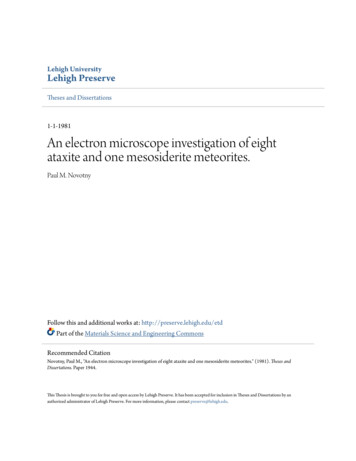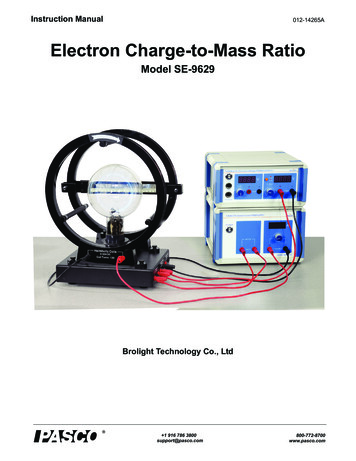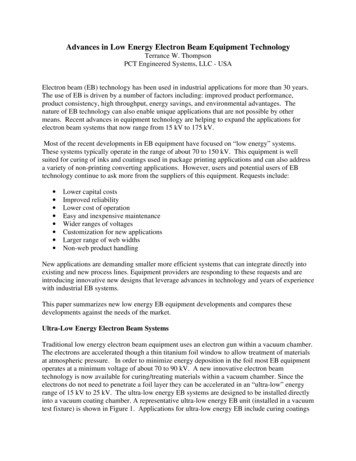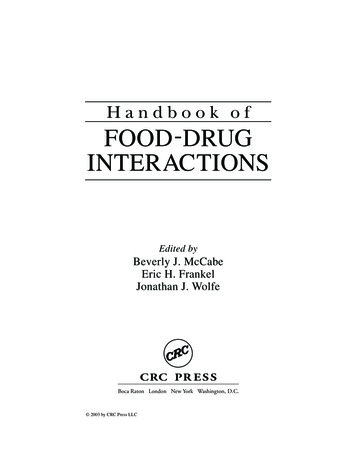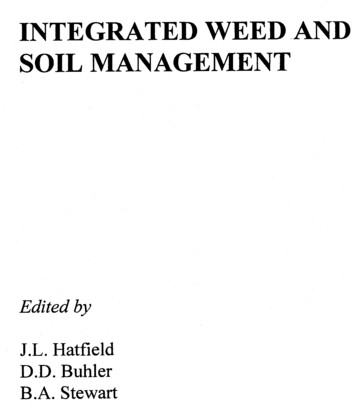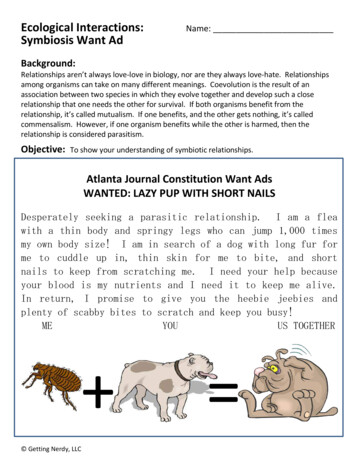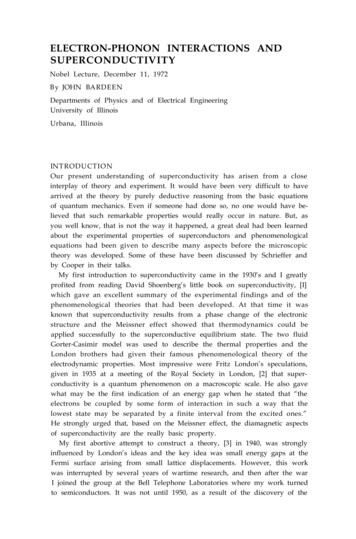
Transcription
ELECTRON-PHONON INTERACTIONS ANDSUPERCONDUCTIVITYNobel Lecture, December 11, 1972B y JOHN BARDEENDepartments of Physics and of Electrical EngineeringUniversity of IllinoisUrbana, IllinoisINTRODUCTIONOur present understanding of superconductivity has arisen from a closeinterplay of theory and experiment. It would have been very difficult to havearrived at the theory by purely deductive reasoning from the basic equationsof quantum mechanics. Even if someone had done so, no one would have believed that such remarkable properties would really occur in nature. But, asyou well know, that is not the way it happened, a great deal had been learnedabout the experimental properties of superconductors and phenomenologicalequations had been given to describe many aspects before the microscopictheory was developed. Some of these have been discussed by Schrieffer andby Cooper in their talks.My first introduction to superconductivity came in the 1930’s and I greatlyprofited from reading David Shoenberg’s little book on superconductivity, [I]which gave an excellent summary of the experimental findings and of thephenomenological theories that had been developed. At that time it wasknown that superconductivity results from a phase change of the electronicstructure and the Meissner effect showed that thermodynamics could beapplied successfully to the superconductive equilibrium state. The two fluidGorter-Casimir model was used to describe the thermal properties and theLondon brothers had given their famous phenomenological theory of theelectrodynamic properties. Most impressive were Fritz London’s speculations,given in 1935 at a meeting of the Royal Society in London, [2] that superconductivity is a quantum phenomenon on a macroscopic scale. He also gavewhat may be the first indication of an energy gap when he stated that “theelectrons be coupled by some form of interaction in such a way that thelowest state may be separated by a finite interval from the excited ones.”He strongly urged that, based on the Meissner effect, the diamagnetic aspectsof superconductivity are the really basic property.My first abortive attempt to construct a theory, [3] in 1940, was stronglyinfluenced by London’s ideas and the key idea was small energy gaps at theFermi surface arising from small lattice displacements. However, this workwas interrupted by several years of wartime research, and then after the warI joined the group at the Bell Telephone Laboratories where my work turnedto semiconductors. It was not until 1950, as a result of the discovery of the
J. Bardeen55isotope effect, that I again began to become interested in superconductivity,and shortly after moved to the University of Illinois.The year 1950 was notable in several respects for superconductivity theory.The experimental discovery of the isotope effect [4, 5] and the independentprediction of H. Fröhlich [6] that superconductivity arises from interactionbetween the electrons and phonons (the quanta of the lattice vibrations) gavethe first clear indication of the directions along which a microscopic theorymight be sought. Also in the same year appeared the phenomenologicalGinzburg-Landau equations which give an excellent description of superconductivity near Tc, in terms of a complex order parameter, as mentionedby Schrieffer in his talk. Finally, it was in 1950 that Fritz London’s book [7]on superconductivity appeared. This book included very perceptive commentsabout the nature of the microscopic theory that have turned out to be remarkably accurate. He suggested that superconductivity requires “a kind ofsolidification or condensation of the average momentum distribution.” Healso predicted the phenomenon of flux quantization, which was not observedfor another dozen years.The field of superconductivity is a vast one with many ramifications. Evenin a series of three talks, it is possible to touch on only a few highlights. Inthis talk, I thought that it might be interesting to trace the development ofthe role of electron-phonon interactions in superconductivity from its beginnings in 1950 up to the present day, both before and after the developmentof the microscopic theory in 1957. By concentrating on this one area, I hopeto give some impression of the great progress that has been made in depthof understanding of the phenomena of superconductivity. Through developments by many people, [8] electron-phonon interactions have grown from aqualitative concept to such an extent that measurements on superconductorsare now used to derive detailed quantitative information about the interactionand its energy dependence. Further, for many of the simpler metals and alloys,it is possible to derive the interaction from first principles and calculate thetransition temperature and other superconducting properties.The theoretical methods used make use of the methods of quantum fieldtheory as adopted to the many-body problem, including Green’s functions,Feynman diagrams, Dyson equations and renormalization concepts. FollowingMatsubara, temperature plays the role of an imaginary time. Even if you arenot familiar with diagrammatic methods, I hope that you will be able tofollow the physical arguments involved.In 1950, diagrammatic methods were just being introduced into quantumfield theory to account for the interaction of electrons with the field of photons.It was several years before they were developed with full power for applicationto the quantum statistical mechanics of many interacting particles. FollowingMatsubara, those prominent in the development of the theoretical methodsinclude Kubo, Martin and Schwinger, and particularly the Soviet physicists,Migdal, Galitski, Abrikosov, Dzyaloshinski, and Gor’kov. The methods werefirst introduced to superconductivity theory by Gor’kov [9] and a little laterin a somewhat different form by Kadanoff and Martin. [10] Problems of
superconductivity have provided many applications for the powerful Green’sfunction methods of many-body theory and these applications have helped tofurther develop the theory.Diagrammatic methods were first applied to discuss electron-phononinteractions in normal metals by Migdal [11] and his method was extendedto superconductors by Eliashberg. [12] A similar approach was given byNambu. [13] The theories are accurate to terms of order (m/M) 1/2 , where mis the mass of the electron and M the mass of the ion, and so give quite accuratequantitative accounts of the properties of both normal metals and superconductors.We will first give a brief discussion of the electron-phonon interactions asapplied to superconductivity theory from 1950 to 1957, when the pairing theorywas introduced, then discuss the Migdal theory as applied to normal metals,and finally discuss Eliashberg’s extension to superconductors and subsequentdevelopments. We will close by saying a few words about applications of thepairing theory to systems other than those involving electron-phonon interactions in metals.DEVELOPMENTS FROM 1 9 5 0 - 1 9 5 7The isotope effect was discovered in the spring of 1950 by Reynolds, Serin,et al, [4] at Rutgers University and by E. Maxwell [5] at the U. S. NationalBureau of Standards. Both groups measured the transition temperatures ofseparated mercury isotopes and found a positive result that could be interpreteda s T cM 1 / 2constant, where M is the isotopic mass. If the mass of the ionsis important, their motion and thus the lattice vibrations must be involved.Independently, Fröhlich, [6] who was then spending the spring term atPurdue University, attempted to develop a theory of superconductivity basedon the self-energy of the electrons in the field of phonons. He heard aboutthe isotope effect in mid-May, shortly before he submitted his paper forpublication and was delighted to find very strong experimental confirmationof his ideas. He used a Hamiltonian, now called the Fröhlich Hamiltonian,in which interactions between electrons and phonons are included but Coulomb interactions are omitted except as they can be included in the energiesof the individual electrons and phonons. Fröhlich used a perturbation theoryapproach and found an instability of the Fermi surface if the electron-phononinteraction were sufficiently strong.When I heard about the isotope effect in early May in a telephone call fromSerin, I attempted to revive my earlier theory of energy gaps at the Fermisurface, with the gaps now arising from dynamic interactions with the phononsrather than from small static lattice displacements. [14] I used a variationalmethod rather than a perturbation approach but the theory was also based onthe electron self-energy in the field of phonons. While we were very hopefulat the time, it soon was found that both theories had grave difficulties, noteasy to overcome. [15] It became evident that nearly all of the self-energy isincluded in the normal state and is little changed in the transition. A theory
J. Bardeen57involving a true many-body interaction between the electrons seemed to berequired to account for superconductivity. Schafroth [16] showed that startingwith the Fröhlich Hamiltonian, one cannot derive the Meissner effect in anyorder of perturbation theory. Migdal’s theory, [II] supposedly correct toterms of order (m/M) 1/2 , gave no gap or instability at the Fermi surface andno indication of superconductivity.Of course Coulomb interactions really are present. The effective directCoulomb interaction between electrons is shielded by the other electrons andthe electrons also shield the ions involved in the vibrational motion. Pines andI derived an effective electron-electron interaction starting from a Hamiltonianin which phonon and Coulomb terms are included from the start. [17] As is thecase for the Fröhlich Hamiltonian, the matrix element for scattering of a pairof electrons near the Fermi surface from exchange of virtual phonons isnegative (attractive) if the energy difference between the electron states involved is less than the phonon energy. As discussed by Schrieffer, the attractivenature of the interaction was a key factor in the development of the microscopic theory. In addition to the phonon induced interaction, there is therepulsive screened Coulomb interaction, and the criterion for superconductivityis that the attractive phonon interaction dominate the Coulomb interactionfor states near the Fermi surface. [18]During the early 1950’s there was increasing evidence for an energy gap atthe Fermi surface. [19] Also very important was Pippard’s proposed non-localmodification [20] of the London electrodynamics which introduced a new lengthinto the theory. In 1955 I wrote a review article [17]the coherence distance,on the theory of superconductivity for the Handbuch der Physik, which waspublished in 1956. The central theme of the article was the energy gap, andit was shown that Pippard’s version of the electrodynamics would likely followfrom an energy gap model. Also included was a review of electron-phononinteractions. It was pointed out that the evidence suggested that all phononsare involved in the transition, not just the long wave length phonons, andthat their frequencies are changed very little in the normal-superconductingtransition. Thus one should be able to use the effective interaction betweenelectrons as a basis for a true many-body theory of the superconducting state.Schrieffer and Cooper described in their talks how we were eventually ableto accomplish this goal.3
Physics 197258Here ψ(r,t) is the wave field operator for electron quasi-particles andφ(r,t) for the phonons, the symbols 1 and 2 represent the space-time points(r1,t1) and (r2,t2) and the brackets represent thermal averages over an ensemble.Fourier transforms of the Green’s functions for H0 He1 Hph for noninteracting electrons and phonons arewhere P (k ,ϖn) and Q (q,vn) are four vectors, ε o (k ) is the bare electronquasiparticle energy referred to the Fermi surface, ϖo,(q) the bare phononfrequency and ϖ n and ϖn the Matsubara frequencies(3)for Fermi and Bose particles, respectively.As a result of the electron-phonon interaction, Hel-ph, both electron andphonon energies are renormalized. The renormalized propagators, G and D,can be given by a sum over Feynman diagrams, each of which represents aterm in the perturbation expansion. We shall use light lines to represent thebare propagators, G o and D o, heavy lines for the renormalized propagators,G and D, straight lines for the electrons and curly lines for the phonons.The electron-phonon interaction is described by the vertexwhich represents scattering of an electron or hole by emission or absorptionof a phonon or creation of an electron and hole by absorption of a phononby an electron in the Fermi sea. Migdal showed that renormalization of the1/2vertex represents only a small correction, of order (m/M ) , a result in accordwith the Born-Oppenheimer adiabatic-approximation. If terms of this orderare neglected, the electron and phonon self-energy corrections are given bythe lowest order diagrams provided that fully renormalized propagators areused in these diagrams.The electron self-energy (P) in the Dyson equation:(4)is given by the diagramThe phonon self-energy, π(Q), defined by
J. Bardeen59is given bySince to order ( m / M ) 1/2 one can use an unrenormalized vertex functiona a0, the Dyson equations form a closed system such that bothandπ(Q) can be determined. The phonon self-energy, π(Q), gives only a smallrenormalization of the phonon frequencies. As to the electrons, Migdal notedthat we are interested in states k very close to kF, so that to a close approximationdepends only on the frequency. For an isotropic system,In the thermal Green’s function formalism, one may make an analyticto the real ω axis to determinecontinuation from the imaginary frequencies,Althoughis small compared with the Fermi energy, E F , it changesrapidly with energy and so can affect the density of states at the Fermi surfacean
Ginzburg-Landau equations which give an excellent description of super-conductivity near T c, in terms of a complex order parameter, as mentioned by Schrieffer in his talk. Finally, it was in 1950 that Fritz London’s book [7] on superconductivity appeared. This book included very perceptive comments
